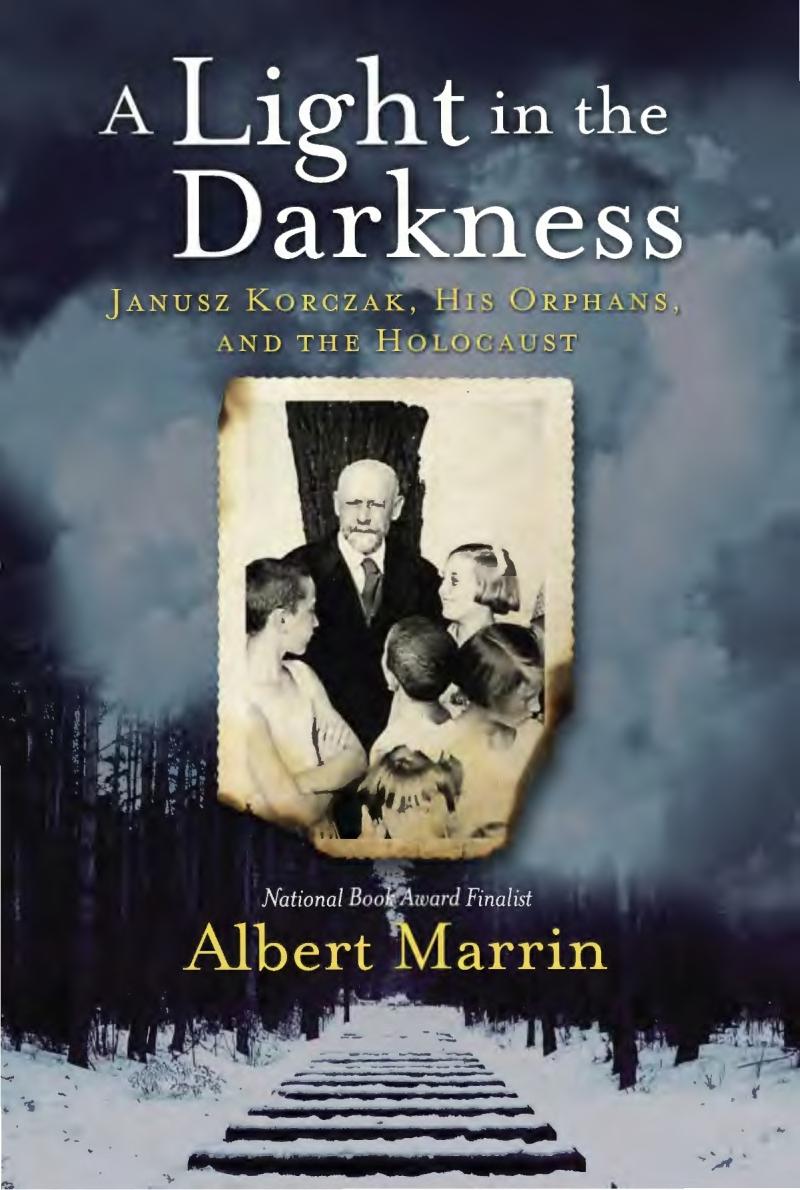
A Light in the Darkness
Janusz Korczak, His Orphans, and the Holocaust
فرمت کتاب
ebook
تاریخ انتشار
2019
Lexile Score
1010
Reading Level
6-8
ATOS
8.2
Interest Level
6-12(MG+)
نویسنده
Albert Marrinشابک
9781524701222
کتاب های مرتبط
- اطلاعات
- نقد و بررسی
- دیدگاه کاربران
نقد و بررسی

July 15, 2019
Janusz Korczak, a Polish-Jewish pediatrician and writer, established a home for orphans in 1912 and cared for Jewish children throughout both world wars. Much more than a biography, Marrin’s introduction to this heroic figure offers an exhaustive study of WWII in Poland and Germany. In straightforward, descriptive language, Marrin (Uprooted: The Japanese American Experience During World War II) explores a vast array of subjects linked to the war, including the history of Palestine and of Judaism in Poland, and he devotes a significant number of pages to a biographical portrait of Adolf Hitler and the growth of Nazism. The narrative, accompanied by black-and-white photos, conveys the horrors of wartime with gruesome details, such as Nazis throwing infants into the air for target practice, and includes tangential subjects, such as sterilization laws in America. Korczak is depicted as a passionate humanitarian with an extraordinary respect and love for children, and as one whose activism was the seed of the human rights movement—in particular, the rights of children. He is often absent from the book, though, as Marrin discusses, in great detail, other topics connected to WWII. Still, there is much to learn and contemplate in this dense yet accessible examination. Ages 12–up. (Sept.)■

July 15, 2019
Janusz Korczak's dedication to orphaned children during World War II serves as a reminder of the good one person can do in a world gone dark. Henryk Goldszmit, known by his pen name, Janusz Korczak, was a quiet, unassuming doctor, veteran, respected author, director of a children's home--and a Jew in Poland at a time when Nazi ideology was on the rise in neighboring Germany. Considered a pioneer in child psychology, Korczak and his chief assistant, Stefania Wilczyńska, operated Dom Sierot, a home for orphans in Warsaw, guided by the philosophy that children were worthy of respect as whole beings, not just future adults, and deserving of autonomy and self-determination. Unfortunately, the nurturing environment of Dom Sierot was no match for the Nazi war machine and Korczak, Wilczyńska, and their beloved children died in the gas chambers of Treblinka in 1942. Marrin (Very, Very, Very Dreadful, 2017, etc.) uses Korczak's life to explore 20th-century Germany's path to extremism and brutality. Going beyond simple biography, the book focuses on eugenics and the Nazi's molding of youth, the roots of anti-Semitism and racism, and their modern legacies. The readable tone makes the long text accessible and engaging. Disappointingly, more attention is paid to Wilczyńska's perceived lack of beauty than to her intellectual accomplishments as a rare woman able at that time to complete a science degree. Meticulous research supports a Holocaust book worthy of attention. (notes, selected sources, index) (Nonfiction. 14-adult)
COPYRIGHT(2019) Kirkus Reviews, ALL RIGHTS RESERVED.

October 18, 2019
Gr 7 Up-Readers of Marrin's new biography will learn that the only memorial stone in the cemetery of the razed Treblinka extermination camp is that of Janusz Korczak (the pen name of Henryk Goldszmit). The outline of his life is sketchy, as most documents have been lost. Korczak was a pediatrician who served Poland in three wars and volunteered for World War II. Nicknamed the Old Doctor, he is primarily known for his work caring for orphans in the Warsaw ghetto. He believed that children should be treated with respect and as individuals, rather than as objects to be molded by adults. Korczak protected the orphans through the Holocaust, turning down several opportunities to escape. On August 5, 1942, a Nazi patrol rounded up everyone in the Dom Sierot orphanage and marched them to trains headed to Treblinka. None survived. In a larger sense, this volume is about Hitler, his racist agenda, and his attitude toward children (and humanity in general), which stands in sharp contrast to the philosophy of Korczak. Marrin describes the horrors of the Holocaust in graphic detail. Often disturbing black-and-white photos enhance the text. Extensive notes for each chapter, accompanied by a comprehensive bibliography and an excellent index, make this book a good research source. VERDICT This fascinating work will terrify and educate readers about the dangers of autocracy and racism. Highly recommended for all young adult collections.-Katherine Koenig, Carnegie Library of Pittsburgh
Copyright 2019 School Library Journal, LLC Used with permission.

Starred review from September 1, 2019
Grades 9-12 *Starred Review* Janusz Korczak, a Polish Jewish physician and an author of books on children's rights, also served as an orphanage director in Warsaw before and during the Holocaust. The Old Doctor refused all rescue offers for himself, accompanying his charges into the Treblinka extermination camp, where he met his death. Marrin's tribute to the humanitarian is not a traditional biography, however; instead, the National Book Award finalist juxtaposes Korczak, who believed hope comes from bettering the lives of children, with Adolf Hitler, who saw children as raw material to be molded into his racial ideology. Through meticulous research and impeccable storytelling, the result is an astonishing account of the Holocaust that alternates between the worst and best of humankind. The author adds context through background information on how Hitler's ideology later played out in WWII, including anti-Semitism and mass killings of Jews in Poland. Amid the horrific details of these deaths shine rays of light from the resistance movement and individuals who risked their own lives to save those of persecuted Jews. Rarely seen photographs help document both sides. The conflicting views of children continue to the end as Marrin both honors Korczak's legacy and reveals how children are still used by terrorists today. Although intended for YA readers, this eye-opening history also belongs in all adult collections. Painful yet profound.(Reprinted with permission of Booklist, copyright 2019, American Library Association.)

























دیدگاه کاربران